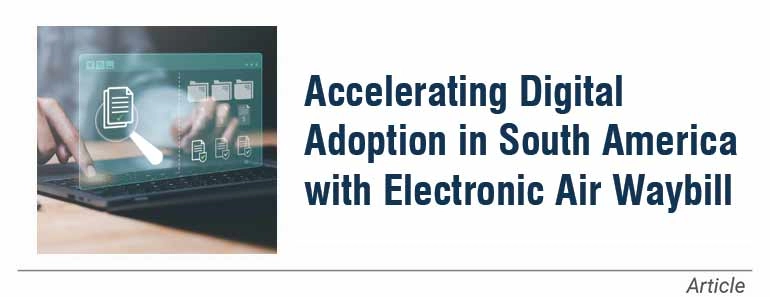
30 Jul Accelerating Digital Adoption in South America with Electronic Air Waybill

The paradigm shift from paper-based processes to digital solutions has become essential for efficiency, sustainability, and accuracy. One of the most significant advancements in this digital transformation is the electronic air waybill (eAWB).
Serving as the digital equivalent of the traditional paper air waybill, the electronic air waybill streamlines cargo documentation, reduces manual errors, and speeds up the entire logistics chain.
While many global markets have already embraced eAWB, South America is emerging as a strong adopter of digital documentation, with industry players across the region accelerating efforts to modernise air freight operations.
The Evolution of eAWB
The air waybill has always been a crucial document in air cargo operations, serving as a contract of carriage and a receipt of goods. Traditionally, this document existed only in paper form, often requiring multiple copies and significant manual processing. However, as the air cargo industry faced increasing demands for faster turnaround times and seamless data exchange, the International Air Transport Association (IATA) introduced the electronic air waybill to replace its paper counterpart.
The electronic air waybill enables carriers, freight forwarders, and ground handlers to share shipment details electronically, eliminating the need for physical documentation. This shift not only reduces paperwork but also ensures data accuracy, as information can be transmitted directly from digital platforms without manual intervention. With air cargo volumes growing and supply chains becoming more complex, the eAWB has become a game-changer for improving operational efficiency.
IATA’s e-Freight initiative push for eAWB
IATA came up with the e-freight initiative to build an end-to-end paperless transportation process for air cargo. It was aimed at making air cargo easier, smarter and faster to accelerate transformation in the areas of digitalisation, visibility and safety. The programme turned out to be an industry-wide initiative involving carriers, freight forwarders, ground handlers, customs brokers, shippers, consignees to name a few.
| Countries | Adoption Rate |
| Brazil | 100% |
| Chile | 30-40% |
| Colombia | 15-25% |
| Peru | 10-20% |
| Ecuador | 5-10% |
| Other Countries (Bolivia, Uruguay, Paraguay & Venezuela) | <5% |
Source: https://airlines.iata.org/2025/04/22/milestone-air-cargo-brazil-adopts-eawb?utm_source=chatgpt.com
Enabling electronic air waybill was the first milestone as part of the e-freight initiative push. Countries like Hong Kong, Singapore, even the USA have rapidly adopted and reached adoption levels as high as 95 per cent. Brazil came as a late entrant and ensured 100 per cent adoption in a span of few months.
On the other hand, countries like Chile, Colombia, Peru and Ecuador have reportedly 10 per cent to 40 per cent adoption so far. Now the question arises. Why the sudden shift?
Why is South America Adopting eAWB Rapidly now?
South America has been one region In recent years, South America has shown remarkable progress in adopting electronic air waybill solutions, driven by several key factors.
- Regulatory Support and Industry Collaboration:
Governments and regulatory bodies across South America are increasingly supporting digitization in logistics and trade. By aligning with global standards such as IATA’s eAWB initiative, these countries are ensuring that their air cargo industries remain competitive in the global market. Collaborative efforts among airlines, freight forwarders, and technology providers have created a conducive environment for digital transformation. - Cost and Time Efficiency:
The logistics industry in South America has long struggled with inefficiencies caused by paper documentation, including delays and higher administrative costs. The electronic air waybill significantly reduces the time required for document processing, enabling faster cargo handling at airports and reducing turnaround times. - Sustainability Goals:
Many South American carriers and logistics companies are prioritizing sustainability as part of their corporate strategies. Replacing paper air waybills with electronic documentation contributes to reducing paper waste, aligning with the region’s growing focus on environmentally friendly business practices. - Technological Advancements:
The rapid growth of cloud-based logistics platforms, electronic data interchange (EDI), and blockchain-based solutions in South America has made the implementation of electronic air waybill systems easier and more cost-effective. Companies are leveraging digital tools to ensure seamless communication between various stakeholders in the cargo supply chain.
Challenges and Future Outlook
While South America is making significant strides, some challenges remain in the widespread adoption of electronic air waybill systems. Smaller airports and freight operators, especially in remote regions, may lack the digital infrastructure required to fully transition to paperless processes. Additionally, varying regulatory frameworks across different countries can slow down harmonized adoption.
However, the future looks promising. With IATA aiming for 100% eAWB adoption globally, South American stakeholders are increasingly motivated to accelerate their digital transition. The region is expected to witness strong growth in integrated digital trade corridors, connecting air cargo operations with maritime and road freight through a unified digital ecosystem.
Emerging technologies like artificial intelligence (AI), blockchain, and data analytics are likely to complement eAWB adoption, ensuring enhanced security and data visibility. As more carriers, freight forwarders, and customs authorities collaborate, South America is poised to become a leader in the global shift toward paperless air cargo documentation.
No longer an upgrade
The electronic air waybill is no longer just a technological upgrade but a necessity for the modern air cargo industry. South America’s rapid adoption of eAWB demonstrates the region’s commitment to enhancing operational efficiency, improving customer experiences, and achieving sustainability goals. By embracing digital documentation, South American logistics players are aligning with global best practices and positioning themselves as competitive players in the international trade landscape.
As digital technologies continue to reshape the future of logistics, the electronic air waybill will remain a cornerstone of efficient, transparent, and environmentally responsible air cargo operations. South America’s progress sets a strong example of how a region can overcome traditional barriers and transition to a more connected and paperless future.
Read more on our Cargo Community System
